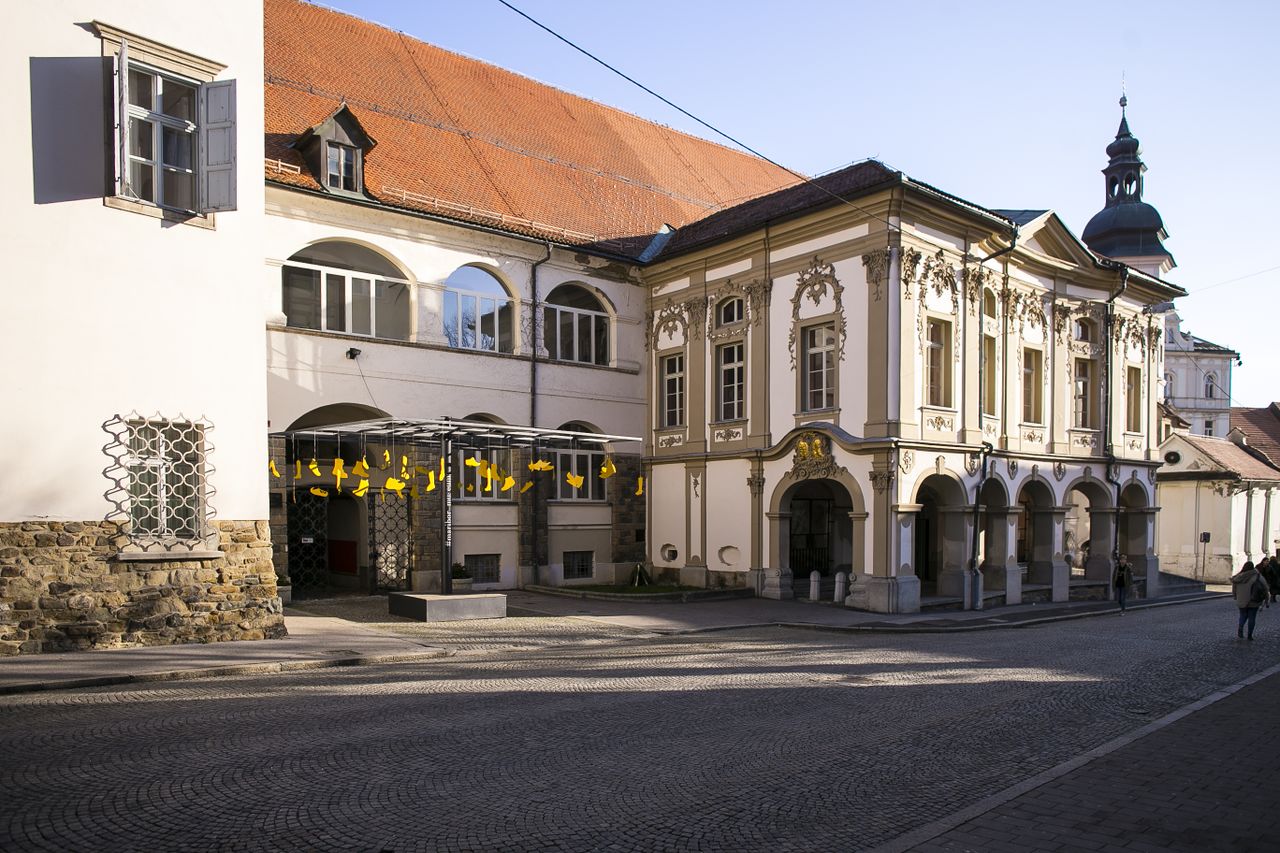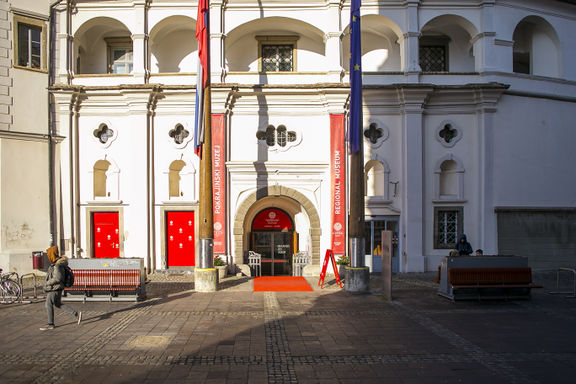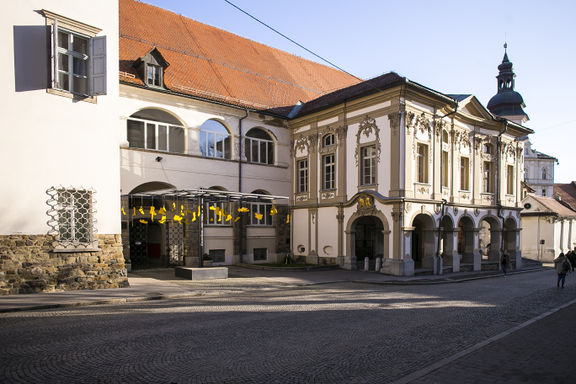Difference between revisions of "Maribor Regional Museum"
m (Text replace - "ROBOT INFOBOX" to "ROBOT WRITING INFOBOX") |
(mwtool_article) |
||
| (52 intermediate revisions by 7 users not shown) | |||
| Line 1: | Line 1: | ||
{{Article | {{Article | ||
| − | | status = | + | | status = NIFERTIK! |
| − | | maintainer = | + | | maintainer = Admin |
}} | }} | ||
{{Infobox | {{Infobox | ||
| name = Maribor Regional Museum | | name = Maribor Regional Museum | ||
| − | | | + | | local name = Pokrajinski muzej Maribor |
| + | | logo = Pmm logo barvni jpeg.jpg | ||
| street = Grajska 2 | | street = Grajska 2 | ||
| town = SI-2000 Maribor | | town = SI-2000 Maribor | ||
| + | | map = http://www.openstreetmap.org/?lon=15.6487&lat=46.56074&zoom=17&layer=mapnik | ||
| telephone = 386 (0) 2 228 3551 | | telephone = 386 (0) 2 228 3551 | ||
| − | | fax = | + | | fax = |
| − | | email = | + | | email = museum@museum-mb.si |
| − | | website = http://www. | + | | website = http://www.museum-mb.si/ |
| − | | | + | | founded by = Municipality of Maribor |
| + | | opening hours = 9am-4pm Tue-Sat, 9am-2pm Sun. Closed Mon, holidays | ||
| contacts = {{Contact | | contacts = {{Contact | ||
| name = Mirjana Koren | | name = Mirjana Koren | ||
| role = Director | | role = Director | ||
| − | | email = mirjana.koren@ | + | | telephone = 386 (0) 2 228 3550 |
| + | | email = mirjana.koren@museum-mb.si | ||
| + | }}{{Contact | ||
| + | | name = | ||
| + | | role = | ||
| + | | street = | ||
| + | | town = | ||
| + | | website = | ||
| + | | email = | ||
}} | }} | ||
| + | | accounts = | ||
| + | https://www.facebook.com/pomum123/ | ||
| + | https://www.instagram.com/maribor_museum/ | ||
| + | https://www.youtube.com/channel/UCdshtCrun841Oc-35tYLBGQ | ||
}} | }} | ||
{{Teaser| | {{Teaser| | ||
| − | The | + | {{wide Image|Maribor Regional Museum 2020 Exterior Photo Janez Klenovsek.jpg}} |
| + | The [[Maribor Regional Museum]] is a multidisciplinary general museum for the broader Maribor region, with its rich archaeological, ethnological and cultural-historical heritage. Originating in [[established::1903]], the museum keeps about one hundred thousand exhibits, coming from different periods from the Neolithic to the present, which are divided into eighteen collections. The museum is located in the [[Maribor Castle]] in the centre of the city and also hosts concerts, lectures and expert meetings. | ||
}} | }} | ||
| − | + | == Background == | |
| + | The origins of the Maribor Regional Museum may be traced back to the late-19th and early-20th centuries, when three separate museum collections existed in Maribor: the Diocesan Museum (founded in 1896); the Museum Society collection (founded in 1902); and the Historical Society for Slovene Styria collection (founded in 1903). These three institutions merged in 1920 and 1924 to form the Maribor Regional Museum. | ||
| − | + | By 1938 the museum housed its collections in the premises of the former prison in today's Cankarjeva Street. In 1938 the museum was relocated to [[Maribor Castle]], and in the same year, a so-called "burger section of the Maribor Regional Museum" was set up. This was followed in 1943 by the establishment of dedicated archaeological and ethnological collections, and in 1947 by the addition of several other special collections. In 1954 part of the museum's art collection was transferred to [[Maribor Art Gallery]], and in 1958 the National Liberation collection was transferred to the new [[Maribor National Liberation Museum]]. A pharmacy collection was added in 1957 and a costume collection – the only one of its kind in Slovenia – was established in 1965. From 1969 the latter also included military uniforms. | |
| − | + | In 1996, the museum completely renewed its restoration workshop. A significant acquisition was also the arrangement of the Museum Exhibition Grounds (''Muzejsko razstavišče''), which unburdened the premises occupied by the permanent museum exhibition. In 2004 the renovation works of the museum building and the museum itself started. A new permanent exhibition was ready in the renovated castle by 2012 when Maribor became the [[Category:Maribor, European Capital of Culture 2012|European Capital of Culture]]. | |
| − | Maribor Regional Museum | + | == Collections == |
| + | The Maribor Castle itself is already rich in major construction achievements, such as its baroque staircase, Loretska Chapel, and Knights' Hall. It hosts 20 collections with over 52,000 exhibits, among them: an '''archaeological collection''' of finds from the area of Podravje from Mežiška dolina to Pomurje; an '''ethnological collection''' of culture of the Alpine area (Pohorje, Kozjak, Carinthia) and of the Pannonian area (Slovenske gorice, Dravsko polje, Pomurje); a '''costume collection''' of noble and middle-class clothing and accessories, a collection of fashionable sheets and collection of uniforms; a '''lapidary collection''' occupies most of the courtyard and corridors and includes several monuments. There is also a Jewish tombstone dating from the 15th century, before Maribor's once sizeable Jewish community was banished in 1497; a '''collection of the town's history''', including the town insignia, the sword and sceptre of the town judge, the town seals from the late 13th to the early 20th century, the keys of the town gates, and a bag for keeping the town's keys; a '''pharmacy collection''', presented in a reconstruction of a pharmacist's dispensary; a '''collection of weapons''' in volume among the largest in Slovenia covers the arms and equipment from the late Middle Ages to the mid-20th century; a '''numismatic collection''' of coins from the 13th to 20th century; an '''art history collection''' of paintings, sculpture and graphics from various parts of Styria from the 14th to 20th century; a '''craft collection''' of domestic and imported ceramic, pewter products, lamps, brass utensils and articles of goldsmiths' craft from the 18th to 19th century, a collection of glassware from the Pohorje glassworks; a '''furniture collection''' of the aristocratic and bourgeois furniture of late Gothic, Renaissance, Baroque, Classicism, Biedermeier and Art Nouveau, a collection of historical clocks and musical instruments. | ||
| + | |||
| + | == Exhibitions == | ||
| + | The renovated permanent exhibition starts in the entry hall with a museum shop and the museum's beginnings, presenting the collections' highlights in the original museum furniture. The exhibition continues chronologically from the prehistoric times and Middle Ages (in the ground floor of the castle’s Bastille) to the ethnological and bourgeois lifestyle collections, including a reconstruction of a historical pharmacy from the late-19th century. The painting, sculpture, uniform, glass, and furniture collections have been presented in an innovative open storage format. | ||
| + | |||
| + | == Publishing == | ||
| + | Publishing activity includes the exhibition catalogues, serial publication ''Osvetljena dediščina'' (The Illuminated Heritage), and publications of scientific papers, like "Na poti strpnosti: monoteistične religije in verska svoboda" (Towards the Tolerance: Monotheistic Religion and Religious Freedom, 2009). The museum has also published several virtual thematic exhibitions online. | ||
| + | |||
| + | == Awards == | ||
| + | The museum's long-standing (1963–1988) director [[Sergej Vrišer]] (1920–2004), also a professor for [[Department of Art History, University of Ljubljana|museology and conservation science]] at the [[University of Ljubljana]], won the [[Stele Award]] in 2001, the [[Izidor Cankar Award]] in 2003, and the [[Valvasor Award]] for his lifetime achievements. | ||
| + | |||
| + | == International cooperation == | ||
| + | The [[Maribor, European Capital of Culture 2012]] has spurred MUSEOEUROPE, the Museum's International Symposium, each year devoted to a specific topic such as textiles, the culture of clothing and fashion (2019), kitchen, food and nutrition (2017), or the Ottoman cultural heritage of the 17th and 18th centuries (2015). | ||
| + | |||
| + | The museum participated in the international project "Bastion", a neighbourhood programme of Slovenia, Hungary and Croatia (since 2005). The project was partly financed by the European Union under the Community Initiative Program INTERREG IIIA. | ||
| + | |||
| + | The international project "TrArS-Tracing the Art of the Straub Family", which involved the [[Institute for the Protection of Cultural Heritage of Slovenia]] and the [[Department of Art History, University of Ljubljana]] dealt also with the exceptional collection of works by Baroque sculptor [[Joseph Straub]] (1712–1756), which is kept in the Maribor Regional Museum. | ||
== See also == | == See also == | ||
| − | * [[Maribor | + | * [[Ptuj – Ormož Regional Museum]] |
| + | * [[Celje Regional Museum]] | ||
| + | |||
| + | == External links == | ||
| + | * [http://www.museum-mb.si/ Maribor Regional Museum website] | ||
| + | |||
| + | {{Gallery}} | ||
[[Category:Museums]] | [[Category:Museums]] | ||
| + | [[Category:Regional museums]] | ||
| + | [[Category:Venues]] | ||
| + | [[Category:Exhibition venues]] | ||
| + | [[Category:Event organisers]] | ||
| + | [[Category:Music venues]] | ||
| + | [[Category:Museum publishers]] | ||
| + | [[Category:Publishers]] | ||
| + | [[Category:Music museums]] | ||
| + | |||
| + | [[Category:Maribor, European Capital of Culture 2012]] | ||
| + | [[Category:Municipal cultural institutions]] | ||
| + | |||
| + | [[Category:Updated 2020]] | ||
| + | [[Category:Music_museums_and_collections]] | ||
Latest revision as of 01:29, 19 February 2021
Background
The origins of the Maribor Regional Museum may be traced back to the late-19th and early-20th centuries, when three separate museum collections existed in Maribor: the Diocesan Museum (founded in 1896); the Museum Society collection (founded in 1902); and the Historical Society for Slovene Styria collection (founded in 1903). These three institutions merged in 1920 and 1924 to form the Maribor Regional Museum.
By 1938 the museum housed its collections in the premises of the former prison in today's Cankarjeva Street. In 1938 the museum was relocated to Maribor Castle, and in the same year, a so-called "burger section of the Maribor Regional Museum" was set up. This was followed in 1943 by the establishment of dedicated archaeological and ethnological collections, and in 1947 by the addition of several other special collections. In 1954 part of the museum's art collection was transferred to Maribor Art Gallery, and in 1958 the National Liberation collection was transferred to the new Maribor National Liberation Museum. A pharmacy collection was added in 1957 and a costume collection – the only one of its kind in Slovenia – was established in 1965. From 1969 the latter also included military uniforms.
In 1996, the museum completely renewed its restoration workshop. A significant acquisition was also the arrangement of the Museum Exhibition Grounds (Muzejsko razstavišče), which unburdened the premises occupied by the permanent museum exhibition. In 2004 the renovation works of the museum building and the museum itself started. A new permanent exhibition was ready in the renovated castle by 2012 when Maribor became the.
Collections
The Maribor Castle itself is already rich in major construction achievements, such as its baroque staircase, Loretska Chapel, and Knights' Hall. It hosts 20 collections with over 52,000 exhibits, among them: an archaeological collection of finds from the area of Podravje from Mežiška dolina to Pomurje; an ethnological collection of culture of the Alpine area (Pohorje, Kozjak, Carinthia) and of the Pannonian area (Slovenske gorice, Dravsko polje, Pomurje); a costume collection of noble and middle-class clothing and accessories, a collection of fashionable sheets and collection of uniforms; a lapidary collection occupies most of the courtyard and corridors and includes several monuments. There is also a Jewish tombstone dating from the 15th century, before Maribor's once sizeable Jewish community was banished in 1497; a collection of the town's history, including the town insignia, the sword and sceptre of the town judge, the town seals from the late 13th to the early 20th century, the keys of the town gates, and a bag for keeping the town's keys; a pharmacy collection, presented in a reconstruction of a pharmacist's dispensary; a collection of weapons in volume among the largest in Slovenia covers the arms and equipment from the late Middle Ages to the mid-20th century; a numismatic collection of coins from the 13th to 20th century; an art history collection of paintings, sculpture and graphics from various parts of Styria from the 14th to 20th century; a craft collection of domestic and imported ceramic, pewter products, lamps, brass utensils and articles of goldsmiths' craft from the 18th to 19th century, a collection of glassware from the Pohorje glassworks; a furniture collection of the aristocratic and bourgeois furniture of late Gothic, Renaissance, Baroque, Classicism, Biedermeier and Art Nouveau, a collection of historical clocks and musical instruments.
Exhibitions
The renovated permanent exhibition starts in the entry hall with a museum shop and the museum's beginnings, presenting the collections' highlights in the original museum furniture. The exhibition continues chronologically from the prehistoric times and Middle Ages (in the ground floor of the castle’s Bastille) to the ethnological and bourgeois lifestyle collections, including a reconstruction of a historical pharmacy from the late-19th century. The painting, sculpture, uniform, glass, and furniture collections have been presented in an innovative open storage format.
Publishing
Publishing activity includes the exhibition catalogues, serial publication Osvetljena dediščina (The Illuminated Heritage), and publications of scientific papers, like "Na poti strpnosti: monoteistične religije in verska svoboda" (Towards the Tolerance: Monotheistic Religion and Religious Freedom, 2009). The museum has also published several virtual thematic exhibitions online.
Awards
The museum's long-standing (1963–1988) director Sergej Vrišer (1920–2004), also a professor for museology and conservation science at the University of Ljubljana, won the Stele Award in 2001, the Izidor Cankar Award in 2003, and the Valvasor Award for his lifetime achievements.
International cooperation
The Maribor, European Capital of Culture 2012 has spurred MUSEOEUROPE, the Museum's International Symposium, each year devoted to a specific topic such as textiles, the culture of clothing and fashion (2019), kitchen, food and nutrition (2017), or the Ottoman cultural heritage of the 17th and 18th centuries (2015).
The museum participated in the international project "Bastion", a neighbourhood programme of Slovenia, Hungary and Croatia (since 2005). The project was partly financed by the European Union under the Community Initiative Program INTERREG IIIA.
The international project "TrArS-Tracing the Art of the Straub Family", which involved the Institute for the Protection of Cultural Heritage of Slovenia and the Department of Art History, University of Ljubljana dealt also with the exceptional collection of works by Baroque sculptor Joseph Straub (1712–1756), which is kept in the Maribor Regional Museum.






